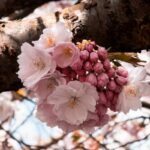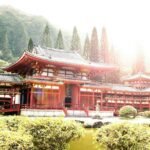While Hanami may look like a leisurely picnic under cherry blossoms, it is, first and foremost, a part of Japanese culture that has endured for over a millennium.
This practice goes beyond appreciating the beauty of flowers — it’s about understanding life’s fleeting nature and the cycles of renewal and endings.
Hanami creates a communal spirit, drawing people together to celebrate the arrival of spring with mutual appreciation and reflection.
But what makes this ancient custom so widespread in modern Japan, and why do cherry blossoms hold such profound symbolism?
The Origins of Hanami
Hanami, which translates to ‘flower viewing,’ has roots that stretch back over a thousand years to Japan’s Nara period. During this era, the Japanese aristocracy began the tradition of blossom viewing, primarily focusing on ume (plum) blossoms.
This changed during the Heian period. Since this time, cherry blossoms had taken center stage, and hanami evolved into a cherished cultural practice.
Hanami is more than just a casual pastime. It’s a deeply ingrained tradition that involves appreciating the fleeting beauty of cherry blossoms.
Originally, the Japanese would gather under the blooming trees to celebrate the natural cycle of life and renewal. They’d enjoy poetry, music, and elaborate feasts, making the most of the cherry blossom season.
The practice of hanami spread beyond the aristocracy, becoming a nationwide phenomenon. Today, people from all walks of life take part in hanami, gathering in parks and gardens to witness the breathtaking spectacle of cherry blossoms in full bloom.
Participating in hanami offers a unique glimpse into a tradition that has shaped Japanese culture for centuries.
Symbolism of Cherry Blossoms

Cherry blossoms symbolize the ephemeral nature of life. In other words, they highlight the beauty and transience of existence.
As you admire the delicate Sakura petals, you’re reminded that life is both fleeting and precious. The brief lifespan of each petal serves as a poignant metaphor for the impermanence that marks our own experiences.
In Japanese culture, sakura holds profound symbolism. The fleeting beauty of these blossoms mirrors the short moments of joy and sorrow that define human life.
In a way, the blossoms help you cherish life’s fleeting beauty before it fades away.
Sakura is often associated with renewal and the cycle of life. Just as the petals fall and new ones bloom, the cherry blossom trees remind you of the continuous cycles of beginnings and endings.
This symbolism resonates deeply within Japanese society. It helps emphasize that while life’s moments are delicate and temporary, they’re also beautiful and worth celebrating.
Hanami in Modern Japan

In modern Japan, the tradition of “flower viewing” seamlessly blends ancient customs with contemporary celebrations. This time-honored practice is a significant event where families, friends, and colleagues gather to celebrate the coming and going of cherry blossoms.
A typical hanami party involves spreading out a blanket under the cherry trees, enjoying food and drinks, and reveling in the picturesque scenery. These picnics often include bento boxes, sake, and seasonal treats to make the atmosphere more festive. A hanami party at night is referred to as yozakura (night sakura).
While many still appreciate the tranquility and natural beauty, modern hanami can also be lively and social, incorporating music and games.
| Aspect | Traditional Hanami | Modern Hanami |
| Setting | Temples and Gardens | Parks and Urban Spaces |
| Food | Simple Bento Boxes | Varied Cuisine and Snacks |
| Beverages | Green Tea | Sake and Soft Drinks |
| Activities | Quiet Reflection | Socializing and Games |
| Duration | Daytime | Day and Night |
How to Celebrate Hanami
Celebrating hanami in a respectful and fun manner is easier than you might think.
It’s a good idea to start by choosing a park known for its cherry blossom displays. Once you have that covered, arrive early in the morning to secure a prime spot. If you arrive too late, you might see nearly all the popular cherry blossom spots already taken by other flower-viewing parties.
Bring a large tarp to sit on, as the ground can be damp. Pack a variety of seasonal delicacies, such as bento boxes, sushi, onigiri, and tempura. If you want something to satisfy your sweet tooth, treats like mochi and dango make perfect desserts. Complement your meal with sake, green tea, or plum wine.
Of course, hanami isn’t just about the food; it’s about immersing yourself in the beauty of the cherry blossoms and enjoying the company of friends and family. The lively atmosphere, filled with laughter and chatter of families and friends, really enhances the experience.
Take time to appreciate the fleeting beauty of the blossoms. Capture the moment with photos, but also take a moment to simply gaze at the delicate flowers swaying gently in the breeze. After all, this is a sight worth remembering forever.
Conclusion
Hanami is a beautiful reminder of life’s fleeting nature and the cycles of renewal and endings. For over a thousand years, this tradition has brought together people from all walks of life to celebrate the arrival of spring with a sense of mutual appreciation and reflection.
Whether it’s through quiet contemplation or lively social gatherings, hanami continues to be an important cultural event that encapsulates the beauty of life and the joy of coming together.
Frequently Asked Questions (FAQs)
What is the origin of the term “hanami”?
The term “hanami” comes from the Japanese words “hana” (花), meaning flower, and “mi” (見), meaning to see or look at. Combined, “hanami” (花見) translates to “flower viewing.” This term specifically refers to the tradition of observing the beauty of cherry blossoms, although it initially encompassed plum blossoms as well.
How has hanami evolved from the Nara period to the present day?
During the Nara period (710-794), hanami began as a practice among the Japanese aristocracy, primarily focusing on ume (plum) blossoms.
However, by the Heian period (794-1185), the focus shifted predominantly to cherry blossoms, and the tradition expanded. Aristocrats would gather under the blooming trees for poetry, music, and elaborate feasts.
Over centuries, hanami transitioned from an elite pastime to a nationwide custom that includes all strata of society. It also now incorporates various modern elements like music and games.
What is the significance of cherry blossoms in Japanese culture?
Cherry blossoms, or sakura, hold profound symbolism in Japanese culture. They underline the ephemeral nature of life, with their brief existence serving as a metaphor for human experiences. Their fleeting beauty is a reminder to cherish life’s moments before they fade.
Sakura also symbolize renewal and the cycles of beginnings and endings, aligning with Buddhist concepts of impermanence.
- What Is a Maiko? - July 13, 2025
- What Does Domo Arigato Mean? - July 12, 2025
- What Does Naruto Mean? - July 12, 2025









